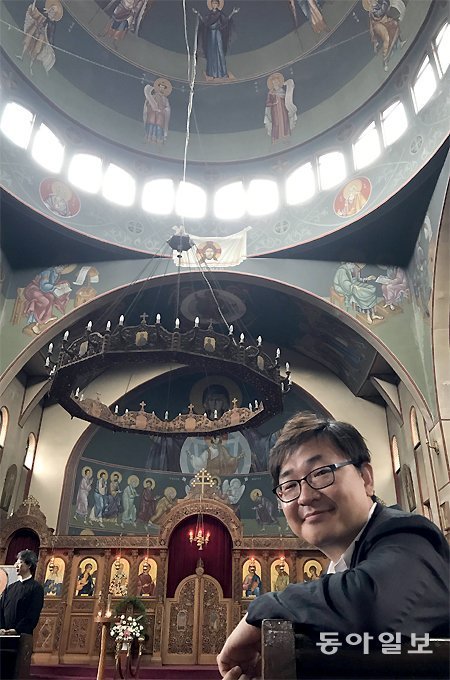Do you know why church murals in Korea and Italy look the same?
Do you know why church murals in Korea and Italy look the same?
Posted July. 05, 2017 07:06,
Updated July. 05, 2017 07:20

An event to celebrate the release of a book titled, "The Story of Art that I Studied for the First Time Vol 3, 4 (Sahoepyeongron)" was held on Tuesday morning at the head church of Korean Orthodox Church that has about 10,000 followers. In the meeting, Yang Jung-moo (50), the author and professor of art theory department at Korea National University of Arts, said that his book contains an overview of art in medieval times centering on the architecture of cathedrals and great churches. He also said that he visited this place that reproduces the Byzantine essence of Orthodox art and cheered himself up whenever he had trouble in writing the book.
There were not many cases of introducing Orthodox art in Korea, comparing to Catholic church art. The author explains that Orthodox art has been established by composing strict formal beauty of religious art by going through the self-reflection after the Veneration of images by the Byzantine Empire in the 8th century.
The church was built in the traditional Masonry construction with steel concrete wall structure and steel frame dome and it had no murals inside the building by the 1990s. Ceiling paintings and murals were painted by Athens Schools of Arts professor Sojos Janudis for three years since 1995. He drew the same paintings in Ulsan church and the words of "supervisor of all things" are written in the middle of ceiling paintings along with images of the Christ.
“The Greek Orthodox Church was very strict in terms of formal beauty but accepted unique languages of the settled regions to deliver the message of God by their own languages,” Bishop Ambrose (Cho Song-am) of Orthodox Metropolis of Korea said. “Religious art can be said as the Bible with a form of art. What is important is to deliver the essence of doctrine through local languages.”
Taek Kyoon Sohn sohn@donga.com



![[단독]점유율 뚝-계약 줄취소…배터리도 구조조정 시사](https://dimg.donga.com/c/138/175/90/1/wps/NEWS/IMAGE/2026/01/15/133159957.1.jpg)


![[단독]“물건 보냈는데 돈 안와”… 국제정세 불안에 수출대금 8000억 떼일 위기](https://dimg.donga.com/c/138/175/90/1/wps/NEWS/IMAGE/2026/01/15/133160131.1.jpg)
